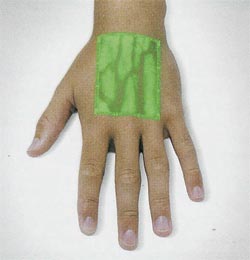This column is dedicated to providing our readers with information regarding new and innovative technological or pharmaceutical developments that may directly or indirectly impact patient safety. By virtue of the unique and long-standing relationship between the APSF and industry, it is inevitable that we will, from time to time, discuss or review products, devices, or pharmaceuticals that may be manufacturered, sold, or distributed by corporations or entities that have or continue to supply financial or in-kind support to the APSF. We will strive to disclose those relationships as appropriate.

Establishing vascular access for administration of medications, or to obtain blood for laboratory tests, is stressful for the patient and can be stressful for the practitioner; limiting the number of sticks is beneficial to both. While most practitioners are adept at venipuncture, patients with extremes in age, habitus, co-morbidities, and multiple punctures present a challenge to even the most experienced. Not uncommonly, the anesthesia team is called upon to obtain venous access after multiple attempts by others in the hospital. By this time, we may be presented with a patient who is stressed, potentially dehydrated, sore, and angry, and with concerned family members. A new technology has been able to “shine a light” on this problem, a green light.
Experienced practitioners have long been able to access the vascular system provided they can see or feel the vessel, or to attempt a blind stick based on anatomical landmarks. Multiple technologies have tried to assist the practitioner to visualize the target. Ultrasound has assisted, but requires the use of gels and a significant learning curve with specialized training. Transillumination with high-intensity light involves direct patient contact, elimination of ambient light, and may result in heating at the site. One infrared device, VeinViewer by Luminetx, uses near-infrared technology to allow the practitioner to visualize the vessel without direct contact, gels, heat, or advanced training. This device projects the image of the vasculature directly onto the patient’s skin, focusing attention on the patient rather than the monitor, and allows both hands to be free to perform the procedure. The practitioner may also visualize arteries as pulsatile structures if they are within the 6-8 mm imaging range of depth.
The near infrared light source is used to differentiate red blood cells from surrounding tissues. The light is reflected back from the surface tissue, but not reflected from the blood in the vessels. The infrared light photons are received by a detector located in the digital video camera; a computer digitizes these photons, produces an image and projects it onto the patient’s skin. The image is displayed in real-time, and veins appear as a black road map on a green field. The non-ionizing energy emitted from the LED light sources is many magnitudes under previously established safety limits.
Whenever a clinician or an institution considers new equipment, safety and cost must be part of the equation. Although the machine is somewhat large, it is self-contained, well-balanced, and relatively easy to move.
This device may help alleviate trips to the operating room for central venous access—offsetting costs and risks that may be deferred by placement of a PICC line or simple peripheral vascular access. Anesthesia, Emergency Room, Radiology, Critical Care, phlebotomists, PICC teams, and others can all utilize this technology throughout the hospital. There is also the potential to update and advance the capabilities of the equipment with software updates imported into the machine via the 2 USB ports. In sum, the VeinViewer can potentially improve patient safety by facilitating intravenous access as an alternative to central venous cannulation, while also reducing patient discomfort.
Dr. Saltzman is Chief of Anesthesiology at Le Bonheur Children’s Medical Center, Memphis, TN.
DISCLOSURES: Luminetx Corporation is a financial contributor to the APSF. Dr. Saltzman has no financial relationship to Luminetx.


 Issue PDF
Issue PDF